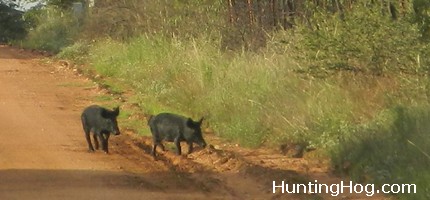The feral hog is a prolific species. Hunting and trapping is necessary to slow the growth of this destructive, non-native animal. Agricultural damage from wild hogs in the US alone numbers is the hundreds of millions of dollars annually. To trap hogs successfully, it’s important to know a little about their feeding habitats, as there has been a significant amount of research done on the species. This information will hopefully help you use tested baiting practices to attract feral hogs for trapping and population control purposes.
Feeding habits of Feral Hogs
Feral hogs have a simple digestive tract. In fact, a pig’s digestive system is very similar to humans. Feral pigs combine a simple stomach with a relatively short large and small intestine. Feral pigs are opportunistic omnivores with the capability of having a varied diet depending on availability of food sources. Based on various feral hog food habit studies, vegetation comprises over 80 percent of their diet. However, animal matter, both vertebrate and invertebrate is also common in the feral hog diet.
Additionally, insects and earthworms are commonly consumed during rooting activities. Animal matter is regularly scavenged from carcasses, too. Direct predation of small mammals, reptiles, and amphibians as well as depredation of the nests of ground nesting birds and deer fawns has been documented, although hogs are not built to be efficient predators. And yes, hogs do eat deer! The bottom line is feral pigs are highly opportunistic omnivores and will take advantage of just about any food resource available in their environment that they can access. Trap success depends on your ability to play on their needs.

Common Baiting Techniques for Wild Hogs
Bait is commonly used to draw feral hogs into traps or increase hunter harvest. There are numerous baits out there and every hog trappers have has their own secret recipe. Successful feral hog baits have included agricultural products, vegetables, animal carcasses, and berry flavorings. However, the most common baits include whole kernel corn and soured whole kernel corn. These baits all have value in attracting feral pigs.
Whole kernel corn – with the increased interest in white-tailed deer and the use of deer feeders, this bait type is probably the most commonly used. Corn is readily available, most hunters already have it on hand for deer, and feral hogs on many properties are very accustomed to feeding on it. Some obvious negatives to this bait is that many non-targets also eat it, including birds, raccoons, javelina, deer, cattle and the list goes on. You don’t want to find deer or other animals in your hog trap, so this is something that must be considered.
Soured whole kernel corn – This basically corn placed in a bucket that is then filled with water and left in the sun for a few days. Soured corn has a pungent odor that should attract feral hogs more readily. This type of bait still has problems with the same non-targets as previously mentioned, but the odor is intended to attract feral pigs more quickly. Adding a berry flavoring to this mixture has also proven effective. This simple bait type is what I use for live trapping hogs, and you can also use grain sorghum (milo), rice or wheat. They all work great when soured.
Hog Trapping and Baiting Recommendations
When selecting a bait to attract feral hogs for trapping or hunting, it is important to understand what feral pigs eat and how they forage. Evaluate your property and located places that pigs are using regularly and see what they are eating. Try to be flexible with your bait types and trap locations. Keep in mind that wild hogs are opportunistic critters. Sometimes a novel bait will be very effective and other times a more natural bait will be the better choice. It never hurts to mix it up.
Also, I recommend using the large corral type trap design over smaller box traps. Hogs learn real quick what a box trap is and they just are not effective and catching large numbers, if any, after a while. You’ll end up catching a couple of small pigs, but the older ones never get caught because the younger ones run in first and spring the trap — educating the remainder of the sounder. Corral traps need to be set baited and opened for at least 7 to 10 days to get older pigs using the trap. I recommend using a game camera to monitor the use of your hog trap. When the whole sounder starts entering the trap, then it’s time to set it and make hay.
I am an animal feed commodity trader. I have truckloads of by products – scrap, off spec, out dated, excess, distressed food products. These are sold for animal feed, and could also work for bait ( as I sell into bear bait in the North US ). If anyone is interested, please drop me an email to discuss any products. Thanks
Tricia,
Thanks for letting hog hunters and trappers know about you products. Sounds like an opportunity for someone.
Where are you located ? Thanks Beau
Beau, if you click on her name it has a link to her web page. This site is not affiliated with the company.
Set my first C Trap today – now wondering how to get them out! Don’t think I want to shoot in trap – blood would taint it. little pigs should not be a problem but bigger sows – even 75 pounds, may be, and will shoot a big boar even if it taints trap! thinking of some kind of snare using boom pole on my tractor. any suggestions. i am trapping them for the meat
Blood won’t taint the trap, it just helps to bring them in!